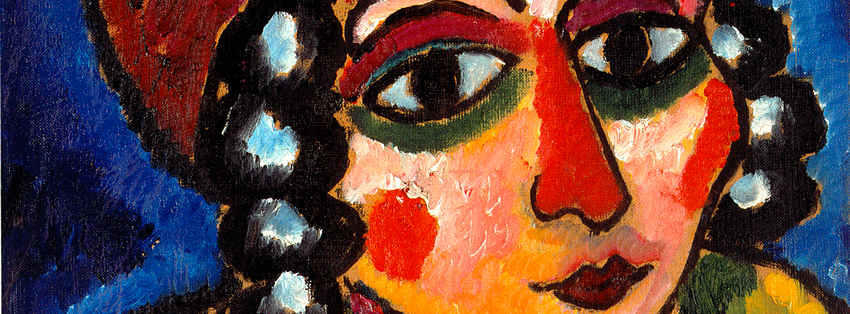Together with Fauvism in France, German Expressionism was the first artistic avant-garde of the twentieth century. The famous groups “Die Brücke” (The Bridge), founded in Dresden in 1905, and “Der Blaue Reiter” (The Blue Knight), born in Munich six years later, not only revolutionized the canons inherited from the late nineteenth-century pictorial experiences , but they also laid the foundations for the development of one of the most important lines of artistic research of the 20th century, destined to influence a significant part of modern experimentation.
The exhibition at the MAN in Nuoro, curated by Tayfun Belgin and Lorenzo Giusti, proposes a rediscovery of the movements of German expressionism through a selection of over one hundred works from the collection of the Osthaus Museum in Hagen, dedicated to the great collector Karl Ernst Osthaus, one of the fathers and supporters of the European artistic and architectural avant-garde, the first in Germany to purchase works by Gauguin and Van Gogh.
In particular, the exhibition places emphasis on two fundamental aspects, which link together the artistic research of the different currents of expressionism: the desire to develop a new form of subjective expression, free from literary, symbolic or thematic conditioning, and the research of primordial values, to be found both in city life and – and above all – in the natural context.
The languages experimented by German artists reacted to the transformations of modern society and the political events of Europe at the beginning of the 20th century. Caught between the conservatism of imperial politics and the growth of a mass culture favored by industrial development, artists thus found refuge in the values of individualism and primordial, in search of authentic and original life experiences.
Authors such as Ernst Ludwig Kirchner, Otto Mueller and Emil Nolde investigated the expression of human bodies, looking both at the workers of the German provinces and at the natives of distant colonies. A work strongly linked to current events, which intended to advance a criticism of the political system and the uncontrolled growth of cities and at the same time reiterate the importance of the individual, with his feelings, his states of mind, within a increasingly massified society.
Nolde in particular – and with him Max Pechstein – undertook long journeys in the German colonial territories overseas, in the South Pacific, while Erich Heckel and Karl Schmidt-Rottluff instead dedicated themselves to the theme of landscape, often working in Dangast, in the moraine territory of the North Sea, where they created works of great originality, with bright and brilliant colours, full of movement and pathos.
These trends were also accompanied by the search for new, more individual forms of religiosity, hence the rediscovery above all of the themes of the Passion of Christ, to which – in addition to Nolde himself – Christian Rohlfs also dedicated himself. The latter, in particular, together with Kirchner and Nolde, was one of the expressionist artists most loved by Osthaus and for thirty-seven years he maintained his own atelier inside the building that housed the collection of the great patron, the Folkwang Museum , inaugurated in Hagen in 1902 thanks to the contribution of Henry Van de Velde, who took care of its furnishings and interior decoration.
In different forms, Franz Marc and Alexej von Jawlensky – leading exponents of the “Blue Knight” group together with Wassily Kandinsky – also testified to a profound spiritual tension, which in the former found expression in the scenarios surrounding his famous animals – almost the search for a new original paradisiacal condition – and in the second it manifested itself instead in the creation of iconic figures, in the wake of the oriental pictorial tradition, carried forward, in an almost obsessive manner, starting from 1911.
Completed with a series of works by Max Pechstein, Lyonel Feininger, Max Beckmann, Max Liebermann, Conrad Felixmüller and Gabriele Münter, the exhibition at the MAN in Nuoro – created in collaboration with the Institut für Kulturaustausch (Tübingen) – constitutes a unique opportunity in Italy for the knowledge of one of the most influential movements in the history of the pictorial avant-garde of the 20th century.
***
Artists on display: Max Beckmann, Walther Bötticher, Lyonel Feininger, Conrad Felixmüller, Erich Heckel, Alexej von Jawlensky, Wassily Kandinsky, Max Liebermann, Ernst Ludwig Kirchner, August Macke, Franz Marc, Ludwig Meidner, Otto Mueller, Gabriele Münter, Emil Nolde , Max Pechstein, Christian Rohlfs, Karl Schmidt-Rottluff.
Tayfun Belgin is director of the Osthaus Museum in Hagen. From 1985 to 1988 he directed the Kunstverein Ruhr in Essen. From 1990 to 2003 he worked as collection manager and department head for the Ostwall Museum in Dortmund. From 2003 to 2007 he directed the Kunsthalle in Krems, Austria. In 2007 he was appointed director of the Osthaus Museum in Hagen. Since 2012 he has also been director of the Cultural Department in Hagen. He has curated numerous national and international exhibitions dedicated to German Expressionist movements and artists, as well as retrospectives on Alexej von Jawlensky, Miró, Immendorff, Lüpertz, Schmidt-Rottluff and others.
Lorenzo Giusti is director of the MAN Museum in Nuoro, for which he has organized retrospective exhibitions dedicated to leading figures in the history of art and photography of the 20th century (Alberto Giacometti, Maria Lai, Jean Arp, Marino Marini, Vivian Maier, Paul Klee, Garry Winogrand) and curated contemporary art projects collaborating with international artists, including, in recent years, Thomas Hirschhorn, Hamish Fulton, Michael Höpfner, Michel Blazy, Roman Signer and others. Curator of the EX3 Center for Contemporary Art in Florence between 2009 and 2012, he is a contract professor at the University of Sassari (Decamaster) and since 2015 a member of the AMACI board (Association of Italian Contemporary Art Museums).

